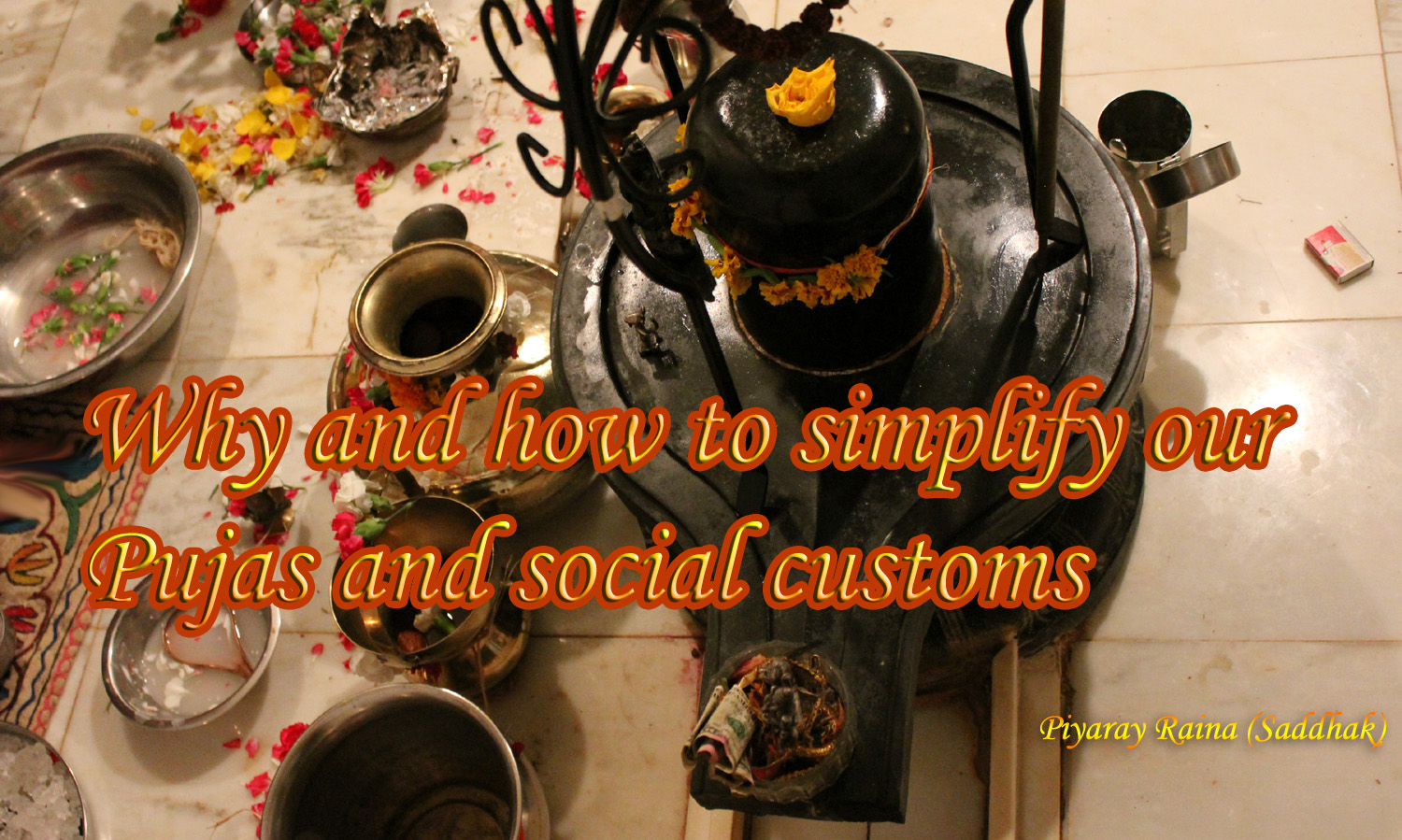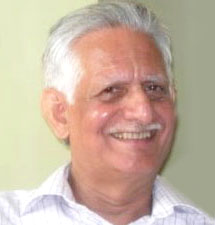
| |
|
One
may or may not agree with the need for the performance of rituals in
the modern times but no one cannot deny the fact that they act as the
bed rock of the community, keeping it alive. We have to continue with
them, but we have the full liberty of changing the format and even
liturgy to suit our times. That is the essence of Sanatana Dharma.
I have studied worship rituals of many Hindu societies while writing my book and am constantly studying the practices of modern generation Hindus both in India and abroad. Let me share with you that no Hindu group has as much lengthy worship rituals as we Kashmiri Pandits do have. As an example, take the case of Prepun- a usual worship in our tradition for almost all occasions. Prepun is just an act of offering bhog (Prasad). In other Hindu traditions bhog is just one of the acts of puja in two lines. Our prepun has more recitation than the whole puja ritual. Similarly, Shivratri Puja includes elaborate ritual of puja followed by homa and tarpan for devas/reshis/pitras. Our antyeshti rituals at the time of death of loved one are equally very lengthy. We are a small community. Had we not moved from Kashmir, our priests would have continued to help us with our traditions. But situation has changed. Our generation of priests, like many all of us has also suffered. They have lost their yajmans on whom they were dependent upon for their livelihood. There is hardly any younger generation of priests. Our puja traditions are now practiced by priests from other Hindu communities who do not follow our traditions. In such a situation, our younger generation is confused. We need to adapt to this new reality. All Karmkandas are not static manuals. They are modified from time to time The present Kashmiri Karmkanda was written in the17th century. It is time we take a fresh look at our worship rituals In the first instance we have to understand the relevance of the Vedic rites in our modern times. All acts, be it religious or otherwise, have a purpose for its performance. We eat only when we are hungry. We perform various religious acts because we are aligned to certain faith mostly through the faith of our ancestors. Hinduism believes in rebirth. As per Vedic Philosophy humans are born to exhaust their impure karma, which are the cause of their repeated births, indicating that being born is not a reward but a punishment, so to say, for indulging in base activities during previous birth. Therefore, the goal of human life should be to seek freedom (MokshaH) from the cycle of repeated births (Samsara) by performing noble acts of YagnyaH, DanaH and TapaH. Acts of YajnyaH, DanaH (gifts) and TapaH (austerity) should not be given up; but should be performed; They are purifying acts Bhagwad Gita 18/5 YajnyaH involves performing of karmic rites by offering food and water to deities called devas who, suffer from hunger and thirst like all beings ) through the medium of Agni Deva (fire god) along with recitation of mantras(sacred recitations composed by Rishis of yore). A large section of the all the four Vedas are devoted to the performance of Vedic ritual of YajnyaH. DanaH is a noble way of gifting materials and money to the needy persons. TapaH means austerity, which is primarily a mental condition whereby one looks at all living beings, including non humans, as divine creations and treats them with humility, compassion and non injury. All these noble acts lead one to MokshaH. Devas are defined as natural elements without any form: fire-Agnideva, water- Varun deva, air Vayu deva.) Visible astral bodies like planets, Sun Moon and even imaginary bodies (like Rahu/ketu) etc were also included in the category of devas. In the Post Vedic Period (300 BC onwards) Vedic liturgy changed. Idol worship was added with the introduction of various idols symbolizing acts of manifestation (Brahma), preservation (Vishnu) and destruction(Shiva)and many more to follow and yet Sanskrit, which is the medium of Vedic rites and hardly understood, has been retained as liturgy to a large extent. Hindu tradition of worship may have gone a sea change but our learned seers, who have appeared from time to time, have protected Hindu Dharma from becoming obsolete, by invigorating it with new life and thoughts .Upanishads, which glorify acts of DanaH and TapaH, have brought new life to Hindu thought .Bhagwad Gita, which is a gist of all Upanishad, represents glory of Hindu faith globally. The Vedic thought is not confined to seeking goal of MokshaH only. It also looks at the journey of a human life from birth to death. Thus, a number of rituals- Sanskaras have been prescribed for performance, at different stages of the life of an individual. Climatic changes in the region have also fixed the timing of rituals. Various types of Pujas (Karmkanda) There are many types of Pujas which are recorded in a manual called karmkanda. 1. Daily worship which invove pujas made daily at home or temple. 2. Festival related worships.Pujas which are made on special occasions like birthday, Shivratri, Divali etc 3. Sanskara related worships which are made in the life of an individual from birth to death 4. Antyeshti- Death rituals at the time of death of an individual and afterwards 5. Havan- A vedic tradition which is observed as a part of Sanskara Puja or as a separate puja. Daily worship
• Havan There are many types of havan which Hindus perform either on special occasions or just to seek fulfillment of their desires. Kashmiris perform havan as a social event also. Some of the common havans are:
The number of homas is as large as the human needs. Kashmiri Hindus perform havans regularly as a social event. Usually five deities namely Ganesh, Durga, Shiv,Vishnu and Surya receive worship. These are called five sahkars. The performance of puja and homa has three stages: a) Pratham Bhaga - It involves recitation of mantras along with actions which are meant to prepare performer both physically and mentally for the ritual. b) Madhyam / Prdhan Bhaga - It represents the main purpose of ritual that is going to be performed. Apprioriate deity who grants this boon is worshipped. c) Uttra Bhaga - This is the concluding part in which deities are thanked for being present during the performance of the ritual and seeking forgiveness for any omissions or mistakes during the performance of the ritual. Part a (Pradhan Bhaga) and Part c (Uttra Bhaga) of a Puja/homa remain same in all Pujas. Part b (Madhyam/Pradhan Bhaga) changes with the type of Puja/homa.3 - Simplification of Kashmiri Karmkanda and Social Customs Simplification A collection of rituals /poojas is known as Karmkanda.In order simplify the Karmkanda two objectives are essential.: 1) Making the performance of ritual easy so as to reduce the dependence on a priest wherever possible. 2) Where services of a priest are essential, make it easy for locally available priests to perform these rituals. In order to achieve above objectives I have worked out simplification as indicated below:
Day One- Mahindirat. The celebration should be limited to midnight only two prepare for the functions of next day. The Music and Dance can start early in the day and continue while food is served Day Two- DevGon and departure/reception of Bharat. The number of bharatis should be limited to blood relations only from both sides to focus on the marriage puja and wonderful traditions associated with it. The idea here is to reduce the fatigue of the couple who have to go through the rituals of DevGon puja at home and then through vivah puja and to minimize the frustration of both the parties in assembling the bharaties and ensure timely departure and huge effort that goes at brides place in arranging food for unspecified number of guests Day Three- Joint Reception. Both sides should invite their guests at a commonly agreed place In western societies the number of guests is confirmed in advance and even seats allotted to them at eating plce .That prevents lot of wasteful expenditure. The expenses should be equally shared by both families. That would be a healthy tradition. Many Hindu societies follow this tradition • Antyeshti from the practical point of view the traditions may be described as under: I) Cremation traditions on the day of death or soon after II) Post cremation traditions Cremation traditions on the day of death are almost universal among Hindus .The tradition of Yama among Kashmiri Pandits on the day of death is unique to Kashmiri Pandits. The present day post cremation traditions among Kashmiri Pandis include:
Alternate Simplified Kriya model is prescribed as under:
I have placed following simplified pujas in PDF format on my blog- www.kp-pooza.blogspot.com: 1) )Janam din Puja(21 pages) 2) Pann Puja(4 pages) 3) Shivratri ( vtk) puja (28 pages) 4) Deepavali Puja(16 pages) 5) KaHnether Puja( 54pages) 6) Upanyana( Mekha)lPuja (71 pages) 7) Vivah Marriage Puja (72 pages) 8) Antyeshti ( death) traditions and pujas (57 pages) 9) Havan ( Homa) puja(46 pages) 10) Vaishdev Bali ( an optional puja addition for Shivratri and Antyeshti (8 pages) 11) Swastivachan( auspicious Vedic Hymns 2 pages) 12) How to perform Tarpan(2 pages) 13) Swastivachan( auspicious Vedic Hymns More are being added Vtk Puja and Mahimnapar recitation with Hindi translation by me is already available on U- tube Please feel free to write to me with your comments and suggestions. | |
|
| |
|---|---|
 Saddhak is the pen name of Mr. Piyaray Raina. He was born in Srinagar
Kashmir in1936.He is Geologist by profession. He received initiation
into spiritual fold at an early age. Married to Krishna, he has a son
Dijjotam ,who lives in Atlanta and a daughter Jyoti ,who lives in
London. He is the author of “ Socio Religious and Cultural Traditions of
Kashmiri Pandits.” Published in 2006. He writes for various community
journals and maintains his website (www.kpsamarpan.org) Mr. Raina lives
in USA with his son and in Gurgaon India Raina family has set up a
Charitable Trust( SamarpanPublic Charitable Trust-regd) in India which
is engagedin running charitable school (Samarpan Bal Kendra- SBK) and
Crystal Children’s Centre-CCC for kids at Gurgaon ,Haryana.The Trust
engaged in various charitable activities.
Saddhak is the pen name of Mr. Piyaray Raina. He was born in Srinagar
Kashmir in1936.He is Geologist by profession. He received initiation
into spiritual fold at an early age. Married to Krishna, he has a son
Dijjotam ,who lives in Atlanta and a daughter Jyoti ,who lives in
London. He is the author of “ Socio Religious and Cultural Traditions of
Kashmiri Pandits.” Published in 2006. He writes for various community
journals and maintains his website (www.kpsamarpan.org) Mr. Raina lives
in USA with his son and in Gurgaon India Raina family has set up a
Charitable Trust( SamarpanPublic Charitable Trust-regd) in India which
is engagedin running charitable school (Samarpan Bal Kendra- SBK) and
Crystal Children’s Centre-CCC for kids at Gurgaon ,Haryana.The Trust
engaged in various charitable activities. |
Friday, October 17, 2014
Various types of Pujas (Karmkanda)
Subscribe to:
Post Comments (Atom)
No comments:
Post a Comment